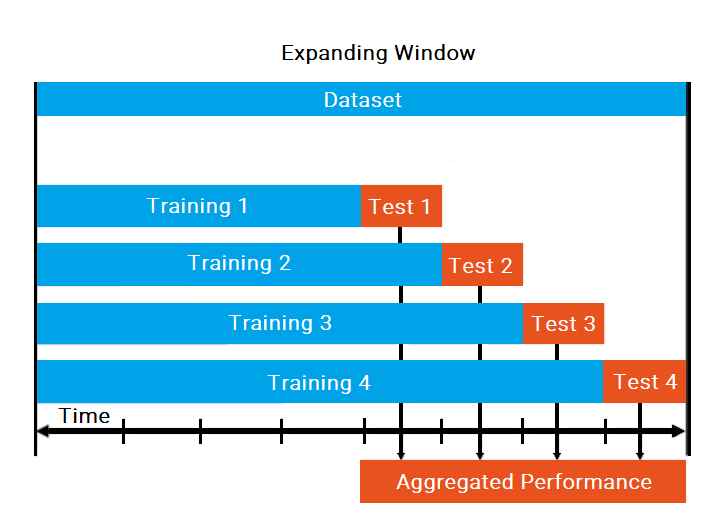TSForecasting is an Automated Time Series Forecasting Framework
Project description
TSForecasting - Automated Time Series Forecasting Framework
Framework Contextualization
The TSForecasting project constitutes an complete and integrated pipeline to Automate Time Series Forecasting applications through the implementation of multivariate approaches integrating regression models referring to modules such as SKLearn, H2O.ai, XGBoost and also univariate approaches of more classics methods such as Prophet and AutoArima, this following an 'Expanding Window' performance evaluation.
The architecture design includes five main sections, these being: data preprocessing, feature engineering, hyperparameter optimization, forecast ensembling and forecasting method selection which are organized and customizable in a pipeline structure.
This project aims at providing the following application capabilities:
-
General applicability on tabular datasets: The developed forecasting procedures are applicable on any data table associated with any Time Series Forecasting scopes.
-
Hyperparameter optimization and customization: It provides full configuration for each model hyperparameter through the customization of
model_configurationsdictionary, allowing optimal performance to be obtained for any use case. -
Robustness and improvement of predictive results: The implementation of the TSForecasting pipeline aims to improve the predictive performance directly associated with the application of the best performing forecasting method.
Main Development Tools
Major frameworks used to built this project:
Performance Evaluation Structure

The Expanding Window evaluation technique is a temporary approximation on the real value of the time series data. The first test segment is selected according to the train length and then it's forecasted in accordance with forecast size. The starting position of the subsequent segment is set in direct relation to the sliding window size, this meaning, if the sliding size is equal to the forecast size, each next segment starts at the end of the previous. This process is repeated until all time series data gets segmented and it uses all the iterations and observations to construct an aggregated and robust performance analysis to each predicted point.
Where to get it
The source code is currently hosted on GitHub at: https://github.com/TsLu1s/TSForecasting
Binary installer for the latest released version is available at the Python Package Index (PyPI).
Installation
To install this package from Pypi repository run the following command:
pip install tsforecasting
Usage Examples
1. TSForecasting - Automated Time Series Forecasting
The first needed step after importing the package is to load a dataset and define your DataTime (datetime64[ns] type) and Target column to be predicted, then rename them to Date and y, respectively.
The following step is to define your future running pipeline parameters variables, these being:
- train_size: Length of Train data in which will be applied the first Expanding Window iteration;
- forecast_size: Full length of test/future ahead predictions;
- sliding_size: Length of sliding window, sliding_size>=forecast_size is suggested;
- models: Select all the models intented to ensemble to evaluation. To fit and compare predictive performance of available models set them in paramater
models:list, options are the following:RandomForestExtraTreesGBRKNNGeneralizedLRXGBoostH2O_AutoMLAutoArimaProphet
- hparameters: Nested dictionary in which are contained all models and specific hyperparameters configurations. Feel free to customize each model as you see fit (customization example shown bellow);
- granularity: Valid interval of periods correlated to data -> 1m,30m,1h,1d,1wk,1mo (default='1d');
- metric: Default predictive evaluation metric is
MAE(Mean Absolute Error), other options areMAPE(Mean Absolute Percentage Error) andMSE(Mean Squared Error);
The fit_forecast method set the default parameters for fitting and comparison of all segmented windows for each selected and configurated model. After implementation, the history method agregates the returning variables fit_performance containing every detailed measure of each window iteration predicted value and fit_predictions measuring all segmented window iterations performance.
The forecast method forecasts the future values based on the previously predefined best performing model.
from tsforecasting.forecasting import TSForecasting
from tsforecasting.parameters import model_configurations
import pandas as pd
import warnings
warnings.filterwarnings("ignore", category=Warning) #-> For a clean console
import h2o
h2o.init() # -> Run only if using H2O_AutoML models
## Dataframe Loading
data = pd.read_csv('csv_directory_path')
data = data.rename(columns={'DateTime_Column': 'Date','Target_Name_Column':'y'})
data = data[['Date',"y"]]
## Get Models Hyperparameters Configurations
parameters = model_configurations()
print(parameters)
# Customization Hyperparameters Example
parameters["RandomForest"]["n_estimators"] = 200
parameters["KNN"]["n_neighbors"] = 5
parameters["Prophet"]["seasonality_mode"] = 'multiplicative'
parameters["H2O_AutoML"]["max_runtime_secs"] = 90
## Fit Forecasting Evaluation
tsf = TSForecasting(train_size = 0.95,
forecast_size = 15,
sliding_size = 15,
models = ['RandomForest','ExtraTrees', 'GBR', 'KNN', 'GeneralizedLR',
'XGBoost', 'AutoArima','Prophet','H2O_AutoML'],
hparameters = parameters,
granularity = "1h", # 1m,30m,1h,1d,1wk,1mo
metric = "MAE" # MAPE, MSE
)
tsf = tsf.fit_forecast(dataset = data)
# Get Fit History
fit_predictions, fit_performance = tsf.history()
## Forecast
forecast = tsf.forecast()
2. TSForecasting - Extra Auxiliar Methods
The engin_date method converts and transforms columns of Datetime type into additional columns (Year, Day of the Year, Season, Month, Day of the month, Day of the week, Weekend, Hour, Minute, Second) which will be added by association to the input dataset and subsequently deletes the original column if parameter drop=True.
The multivariable_lag method creats all the past lags related to the target y feature automatically (in accordance to range_lags parameter) and adds each constructed column into the dataset.
# Feature Engineering
from tsforecasting.treatment import Treatment
tr = Treatment()
data = tr.engin_date(dataset = data,
drop = False)
data = tr.multivariable_lag(dataset = data,
range_lags = [1,10],
drop_na = True)
License
Distributed under the MIT License. See LICENSE for more information.
Contact
Luis Santos - LinkedIn
Project details
Release history Release notifications | RSS feed
Download files
Download the file for your platform. If you're not sure which to choose, learn more about installing packages.
Source Distributions
Built Distribution
Hashes for tsforecasting-1.2.76-py3-none-any.whl
| Algorithm | Hash digest | |
|---|---|---|
| SHA256 | f161f14939942486c4db35e49a71e3ba12bfa82bc2756bdb726e87be8e096b98 |
|
| MD5 | e1956726bef8eafce907280f7e4ce23f |
|
| BLAKE2b-256 | 38433af5fd1b1a5cf6c48c8f8ec84f09439776ed20a87d075f762469c2228579 |











